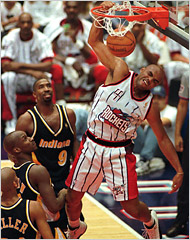How many times have you heard or read that a basketball player is listed at, say, 6 feet 8 inches but that he is really closer to 6-6? Do you ever wonder how something as objective as height can be in doubt, especially for elite players?
“They lie,” said Charles Barkley, a basketball commentator for TNT. “I’ve been measured at 6-5, 6-4 ¾. But I started in college at 6-6.”
Even the N.B.A. lies, apparently. According to Barkley’s biography on NBA.com, he is 6-6.
High school coaches are the first perpetrators, trying to give their players a recruiting edge.
“College coaches pay a hell of a lot better attention when a guy is 6 feet instead of 5-11,” said Chris Ekstrand, a consultant to the N.B.A. who was the longtime editor of its draft guide. “And if you have a 6-7 wunderkind rebounder, you list him at 6-8 to get Division I scouts to notice.”
There is a psychological game going on, too. When a player thinks his opponent is taller, he may give that opponent more respect than he deserves for rebounding — and less than he deserves for quickness. This can be good for several points and rebounds before the player adjusts.
Continue reading the main storySix feet is a touchstone for guards, as 6-8 is for rebounders. But the second number may be heading downward as rules have softened physical play and helped forwards like Shawn Marion, who is listed at 6-7 but is probably more like 6-5 or 6-6, become imposing rebounders.
Seven feet is the opposite case. When a player is much taller, scouts start to worry that he is a stiff. Chinese authorities probably played down Yao Ming’s height, saying he is 7-5 when the N.B.A. lists him at 7-6.

It is no different in women’s basketball, for the same reason, said Steven Key, the coach and general manager of the Chicago Sky of the W.N.B.A.
Key said he had become adept at using scouts’ tactics.
“I stand in the tunnel when a player walks by,” he said. “I’m a true 6-4. If she doesn’t come up past my chin, then I know she’s not 6-1 as claimed.”
The truth about players’ heights is revealed before they turn professional. For the N.B.A., that moment may come at the predraft camp in Orlando, Fla.; the Portsmouth Invitational Tournament, a showcase for college players in Virginia; or in teams’ private workouts.
At Portsmouth, Ryan Blake, the N.B.A.’s assistant director of scouting, places a hardcover book on each player’s head before measuring him.
“It’s my Martin Luther King biography — 800-and-something pages,” Blake said.
He measures players in stocking feet and in shoes because soles vary. These vital statistics, as well as wingspan, vertical reach and vertical leap, are made available to pro scouts. But some players resist Blake’s regimen.
“A little guy came in, he was from Fordham or somewhere, listed at 5-8,” Blake said. “He left and came back with some Timberland boots and about four pairs of socks. We didn’t let him get measured.”
Teams will have no doubt about heights when they make their choices at Thursday’s N.B.A. draft. But the league may never again be so precise, even in official publications like game programs. Once a player is known to be 6-8, he does not want to admit being 6-6. So-called program heights travel with players like good-luck charms, and many club and league officials do not push for accuracy. Neither do journalists.
Sam Smith, a longtime N.B.A. writer who recently retired from The Chicago Tribune, said: “We sort of know the heights, because after camp, the sheet comes out. But you use that height, and the player gets mad. And then you hear from his agent. Or you file your story with the right height, and the copy desk changes it because they have the ‘official’ N.B.A. media guide, which is wrong. So you sort of go along with the joke.”
Continue reading the main story
